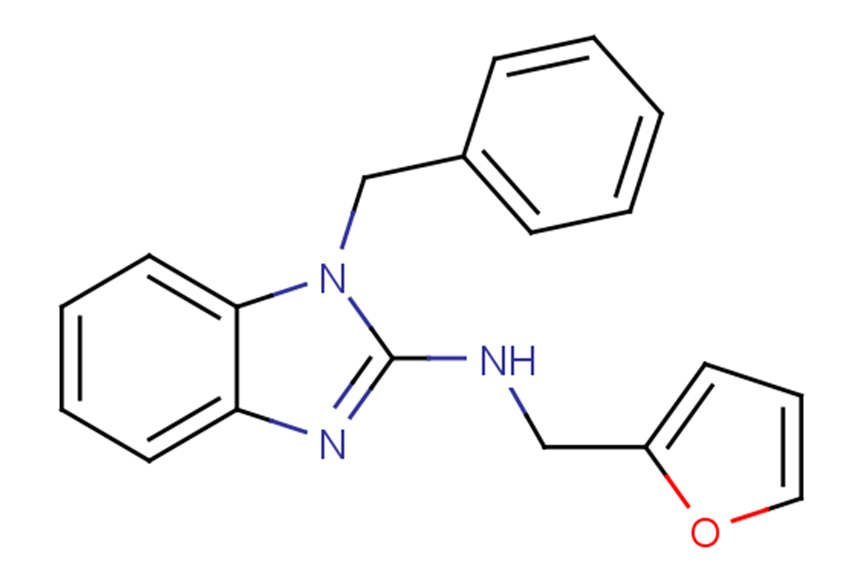
AC1903
CAS No. 831234-13-0
AC1903( —— )
Catalog No. M22075 CAS No. 831234-13-0
AC1903 is a specific inhibitor of TRPC5 channel, and has been shown to suppress severe proteinuria and prevent podocyte loss.AC1903, that specifically blocks TRPC5 channel activity in glomeruli of proteinuric rats.?
Purity : >98% (HPLC)
 COA
COA
 Datasheet
Datasheet
 HNMR
HNMR
 HPLC
HPLC
 MSDS
MSDS
 Handing Instructions
Handing Instructions
| Size | Price / USD | Stock | Quantity |
| 5MG | 48 | In Stock |


|
| 10MG | 82 | In Stock |


|
| 25MG | 178 | In Stock |


|
| 50MG | 310 | In Stock |


|
| 100MG | Get Quote | In Stock |


|
| 200MG | Get Quote | In Stock |


|
| 500MG | Get Quote | In Stock |


|
| 1G | Get Quote | In Stock |


|
Biological Information
-
Product NameAC1903
-
NoteResearch use only, not for human use.
-
Brief DescriptionAC1903 is a specific inhibitor of TRPC5 channel, and has been shown to suppress severe proteinuria and prevent podocyte loss.AC1903, that specifically blocks TRPC5 channel activity in glomeruli of proteinuric rats.?
-
DescriptionAC1903 is a specific inhibitor of TRPC5 channel, and has been shown to suppress severe proteinuria and prevent podocyte loss.AC1903, that specifically blocks TRPC5 channel activity in glomeruli of proteinuric rats.?Chronic administration of AC1903 suppressed severe proteinuria and prevented podocyte loss in a transgenic rat model of FSGS.AC1903 also provided therapeutic benefit in a rat model of hypertensive proteinuric kidney disease.?TRPC5 activity drives disease and that TRPC5 inhibitors may be valuable for the treatment of progressive kidney diseases.
-
In VitroTRPC5 is a Ca2+?permeable nonselective cation channel highly expressed in brain and kidney.AC1903 (0-100 μM) blocks riluzole-activated TRPC5 whole-cell current, but fails to block carbachol (CCh)–induced TRPC4 and OAG-induced TRPC6 currents, even at high micromolar concentrations in Patch-clamp electrophysiology experiments. The ICIC50 values of ML204 (HY-12949) (IC50=13.6 μM) and AC1903 (IC50=14.7 μM) are nearly equipotent in human embryonic kidney 293 (HEK-293) cells expressing TRPC5.AC1903 (30 μM) inhibits angiotensin II-induced production of reactive oxygen species (ROS) in wild-type podocytes and podocytes expressing a mutant angiotensin II type 1 (AT1) receptor that cannot be inactivated and endocytosed.AC1903 (30 μM) blocks caAT1R-induced ROS generation. Increased podocyte cell death within 36 hours of caAT1R expression?is observed, but AC1903 ?protects podocyte cells from cell death. Cell Viability Assay Cell Line:Podocyte cells Concentration:30 μM Incubation Time:36 hours Result:Rescued podocyte cell death.
-
In VivoAC1903 (intraperitoneal injection; 50 mg/kg; twice per day; 7 days) significantly suppresses proteinuria as well as reduces pseudocyst formation and podocyte loss in an AT1?receptor transgenic rat model of kidney disease.AC1903 (intraperitoneal injection; 50 mg/kg; twice per day; initiated on day 7 and treated for 1 week until day 14) initiatation on day 7 exhibits significant suppression of proteinuria with preserved podocyte numbers. Besides, AC1903 does not affect the mean arterial pressure (MAP) and exhibits no effect on body weight, blood urea nitrogen, or creatinine in Dahl S rats. Animal Model:Hypertension-induced focal segmental glomerulosclerosis (FSGS) model in Dahl salt-sensitive rats Dosage:50 mg/kg Administration:Intraperitoneal injection; 50 mg/kg; twice per day; 7 days Result:Inhibited the progression of proteinuric kidney disease by preserving podocytes. Animal Model:6-week-old Dahl S rats received 2% NaCl for 1 week with severe, progressive proteinuric disease Dosage:50 mg/kg Administration:Intraperitoneal injection; 50 mg/kg; twice per day; initiated on day 7 and treated for 1 week until day 14 Result: Decreased the rate of proteinuria when administered at the beginning of a high-salt diet and prevents progression when administered one week following initiation of a high-salt diet.
-
Synonyms——
-
PathwayMembrane Transporter/Ion Channel
-
TargetTRP/TRPV Channel
-
RecptorTRPC5
-
Research Area——
-
Indication——
Chemical Information
-
CAS Number831234-13-0
-
Formula Weight303.36
-
Molecular FormulaC19H17N3O
-
Purity>98% (HPLC)
-
SolubilityIn Vitro:?DMSO : 100 mg/mL (329.64 mM)
-
SMILESC(NC1=NC2=CC=CC=C2N1CC1=CC=CC=C1)C1=CC=CO1
-
Chemical Name——
Shipping & Storage Information
-
Storage(-20℃)
-
ShippingWith Ice Pack
-
Stability≥ 2 years
Reference
1. Sharma S H , Pablo J L , Montesinos M S , et al. Design, synthesis and characterization of novel N-heterocyclic-1-benzyl-1H-benzo[d]imidazole-2-amines as selective TRPC5 inhibitors leading to the identification of the selective compound, AC1903[J]. Bioorganic & Medicinal Chemistry Letters, 2018.
molnova catalog



related products
-
SB-705498
A potent, selective and orally bioavailable TRPV1 antagonist with pKi of 7.6 (inhibition of capsaicin-mediated activation of hTRPV1 receptor).
-
TRPV4 agonist-1 free...
TRPV4 agonist-1 free base?is an agonist of transient receptor potential vanilloid 4 (TRPV4;EC50 of 60 nM, in the hTRPV4 Ca2+ assay).
-
SAR7334
SAR7334 is a potent and specific inhibitor of TRPC6(IC50 of 7.9 nM).



 Cart
Cart
 sales@molnova.com
sales@molnova.com


